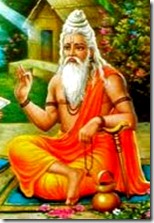 “I offer my respectful obeisances unto all the Vaishnava devotees of the Lord. They can fulfill the desires of everyone, just like desire trees, and they are full of compassion for the fallen souls.” (Vaishnava-pranama)
“I offer my respectful obeisances unto all the Vaishnava devotees of the Lord. They can fulfill the desires of everyone, just like desire trees, and they are full of compassion for the fallen souls.” (Vaishnava-pranama)It is the settled conclusion of the Vedic seers that the greatest benediction in life is to have the association of saints. More specifically, if the dust coming from the lotus feet of the guru, or
spiritual master, can be accepted just one time, there is no counting the number of spiritual merits, or
sukriti, that follows. Just humbly submitting before any person is difficult enough, so the need for surrendering before a human being recognized for his wisdom and knowledge of spiritual matters takes many lifetimes to accept. But to those who do find the bona fide guru and bask in his association, the benefits reaped are too many to count, and the credit for the subsequent success goes directly to the spiritual master and his teachers. Since the guru can never be fully appreciated for his impact, occasions like Vyasa Puja allow for some time to reflect on the mercy of the spiritual master and what he is capable of.

A
puja is a formalized worship, wherein obeisances are offered to the beneficiary of the ceremony. Vyasa refers to
Vyasadeva, the literary incarnation of the Supreme Personality of Godhead,
Lord Krishna. The Vedas are the oldest scriptures in existence, and since they emanate directly from Krishna and describe devotion to Him, they are considered non-different from Him. As the Vedas were originally just one work consisting of prayers and hymns, they could only be understood by the purest men. As time passes from the beginning of creation, man’s ability to think critically and retain relevant pieces of information dwindles. Therefore Vyasadeva comes to divide the Vedas and write supplementary literature known as the Puranas. Vyasadeva compiled so much literature that some people refuse to believe that he even existed. Proof of his influence and divine nature is seen, however, in the behavior and glories of his disciples and their descendants. The bona fide spiritual master is one whose line of instruction is either linked to Vyasa or at least reaches the same conclusion that he put forth, that life’s aim is to worship the Supreme Lord Hari, the original Personality of Godhead.
Interestingly enough, having the audience of a pure devotee is considered a greater blessing than actually meeting the Lord in person. Shri Narada Muni, the spiritual master of Vyasadeva, was blessed through good association, as was
Valmiki, who was originally a dacoit. Meeting the Supreme Lord in person is certainly a terrific reward, but, at the same time, it doesn’t automatically lead to one’s knowing how to act and what their true nature is. The devotee, on the other hand, lives bhakti-yoga, or
devotional service, therefore they are deputed by the Supreme Lord to teach others about what they have learned and how to make the most out of the human form of life.

The spirit soul is the essence of identity within any life form, but only with a human birth can the soul take the necessary steps to reacquaint itself with its true dharma, or foremost characteristic. One who takes instruction from a
brahmana, or a priest devoted to real
religion, earns the title of
dvija, or one who is twice-born. The first birth is from the parents, but this doesn’t automatically awaken the dormant God consciousness resting within the heart. The instruction provided by the spiritual master gives the second and more important birth. The rekindling of the torchlight of knowledge that is part and parcel of the soul is the more important giver of life. Since this birth comes from the guru, how can his glories ever be fully appreciated?
Since man is forgetful of his constitutional position, those who accept the instructions of the spiritual master and take them to heart will acquire tremendous skills. The guru’s primary teaching is that one devote themselves to bhakti-yoga. The quintessential act of bhakti is the
chanting of the holy names, “
Hare Krishna Hare Krishna, Krishna Krishna, Hare Hare, Hare Rama Hare Rama, Rama Rama, Hare Hare”. There are other spiritual teachers who provide different instructions, such as how to do meditational yoga, how to study Vedanta, and how to work without attachment to the results. These instructions can be beneficial, but they fail to extract the full potential for love found within the soul.

It is for this reason that the dust of the lotus feet of the devotee is considered life’s greatest blessing. In the Vedic tradition there are many sacred places of pilgrimage known as
tirthas. Just by visiting these places, so many benedictions are guaranteed. These spots are related to
Lord Vishnu in some way or another. Vishnu is another name for Krishna which means the “all-pervading”. In His Vishnu form, the Lord is opulently adorned and has four hands instead of two. The sacred pilgrimage sites are full of saints, who use the auspicious surroundings to increase the efficacy of their service. This shows how pure the Supreme Lord is. Any ordinary river is not that important, but one attached to Vishnu becomes visited by millions of people each year. Similarly, there are tons of teachers and
devotees of objects not related to God, but they are not given the attention that the saints are, those who are intimately associated with Bhagavan, the Supreme Lord fully endowed with every beneficial attribute. The potential to meet saints is the real benefit of visiting a
tirtha, as the relationship with Vishnu fully matures through their association.
The guru can be considered the travelling tirtha, as he brings with him the auspiciousness found in the sacred pilgrimage sites. This auspiciousness is present in every aspect of the spiritual master, including the dust that comes from his feet. The lotus feet of the guru are the cherished objects for the devotee because they symbolize the proper way to approach God. Through humility, kind submission, and service to one who is deserving of it, true enlightenment can be revealed.

What is the result of following the chanting prescriptions and the restrictions on meat eating,
gambling,
intoxication and
illicit sex? As Krishna consciousness awakens from within, many new abilities arise. All of a sudden the person who was previously dumb, lazy, and harboring a hateful attitude can produce volumes upon volumes of literature praising their beloved Lord and His devotees. They may not even have had any formal training in writing, grammar, or composition. They may even have done poorly during their school years in these subjects. Yet simply from hearing
Krishna-katha, talks about Shri Krishna, and the beauty of devotional service from the guru, the humble soul can become an expert reciter, never running out of material to share with the general public.
When someone becomes skilled in a particular field, it’s not surprising that they would garner a lot of attention. The Vaishnava poets, singers and writers are the most glorified, for their fame stretches the full boundaries of time and space. Their glories know no end, and they continue to be honored and worshiped long after they physically leave the earth. The real credit for superexcellent ability in spiritual endeavors actually goes to the guru, for without his planting of the seed of the creeper of devotional service, bhakti-lata-bija, the full blown tree of transcendental ecstasy and its resultant fruits would never have manifest.

If the guru is due credit for the wonderful writings of his disciples, how can he ever be properly honored? With each new work produced the guru’s fame and glory further increase. In this respect, His Divine Grace
A.C. Bhaktivedanta Swami Prabhupada is worthy of endless adoration. Not only did he personally accept thousands of disciples during his time on earth, through his published works and recorded lectures he continues to rescue those swimming in the sea of nescience. So many past lives have been spoiled pursuing sense gratification, but Shrila Prabhupada doesn’t hold this against anyone. His message comes directly from Krishna, so it is very powerful and can turn even the biggest fool into a genius.
An issue of contention may be raised regarding the negative traits exhibited by disciples and devotees who took instruction from a guru. If a saint deserves the credit for the wonderful qualities of his disciples, including the brilliance of their writings, shouldn’t he then be blamed for their shortcomings? Though this seems logical enough, the rules don’t apply equally. To explain this the example most often cited is that of fire and its production of smoke. Fire is a purifying agent, as it can disintegrate pretty much anything. Though the fire can produce smoke, which is impure, the fire itself never loses its properties. Similarly, the guru may have some errant disciples who can be compared to smoke, but this doesn’t diminish his standing whatsoever.
Isn’t this a cop out though? The guru gets the credit for all the good, but then gets none of the blame for the bad? How does this make any sense? Let’s think of it this way: The bad qualities are always there in a person. By “bad”, we refer to anything that is divorced of its relationship to God. A sinful reaction is really just the negative consequence to doing something incorrectly. Since we know that the spirit soul’s original home is in the spiritual sky alongside God in His personal form, any soul who takes birth in a realm governed by
reincarnation must be considered sinful. Moreover, from our present birth we know that in the past we failed to become fully God conscious by the time of death.
“Whatever state of being one remembers when he quits his body, that state he will attain without fail.” (Lord Krishna,
Bhagavad-gita, 8.6)

The Bhagavad-gita, Krishna’s direct instructions offered on the battlefield of Kurukshetra some five thousand years ago, reveals that whatever state of mind we have at the time of death, that state we will attain without fail. Since our present birth is in a human form, where we are born ignorant of the Supreme Lord’s divine nature and the need for worshiping Him, by rule our consciousness at the time of our previous death was not focused on God. Thus every material birth is sinful, with man having an innate tendency towards following bad habits.
The bona fide guru is thus not responsible for the sinful behavior in man. This penchant is already given to us at the time of birth, or, more accurately, it is provided to us through our wishes. The guru teaches devotional service and how to throw away attachment to sinful activity. If, after taking instruction from him, the sinful behavior continues, it should be understood that the root elements of desire for material association remained, sort of like the last flames of a raging fire that has almost been put out. If the guru doesn’t teach attachment to sinful behavior, how can he be blamed for the mistakes made by his disciples?
The glories of the guru are too many to count. His presence in our lives is directly due to Krishna’s intervention. Those who sincerely desire to have the Lord’s association and be able to think of Him without fail will never be denied. That precious dust from the lotus feet of the spiritual master will come soon enough. No greater gift can be found in this world than the association of saints. On this Vyasa Puja day we honor and remember one of the more notable saints in modern times, Shrila Prabhupada, who lives on forever through his recorded instructions.
 “I offer my respectful obeisances unto all the Vaishnava devotees of the Lord. They can fulfill the desires of everyone, just like desire trees, and they are full of compassion for the fallen souls.” (Vaishnava-pranama)
“I offer my respectful obeisances unto all the Vaishnava devotees of the Lord. They can fulfill the desires of everyone, just like desire trees, and they are full of compassion for the fallen souls.” (Vaishnava-pranama) A puja is a formalized worship, wherein obeisances are offered to the beneficiary of the ceremony. Vyasa refers to
A puja is a formalized worship, wherein obeisances are offered to the beneficiary of the ceremony. Vyasa refers to  The spirit soul is the essence of identity within any life form, but only with a human birth can the soul take the necessary steps to reacquaint itself with its true dharma, or foremost characteristic. One who takes instruction from a brahmana, or a priest devoted to real
The spirit soul is the essence of identity within any life form, but only with a human birth can the soul take the necessary steps to reacquaint itself with its true dharma, or foremost characteristic. One who takes instruction from a brahmana, or a priest devoted to real  It is for this reason that the dust of the lotus feet of the devotee is considered life’s greatest blessing. In the Vedic tradition there are many sacred places of pilgrimage known as tirthas. Just by visiting these places, so many benedictions are guaranteed. These spots are related to
It is for this reason that the dust of the lotus feet of the devotee is considered life’s greatest blessing. In the Vedic tradition there are many sacred places of pilgrimage known as tirthas. Just by visiting these places, so many benedictions are guaranteed. These spots are related to  What is the result of following the chanting prescriptions and the restrictions on meat eating,
What is the result of following the chanting prescriptions and the restrictions on meat eating,  If the guru is due credit for the wonderful writings of his disciples, how can he ever be properly honored? With each new work produced the guru’s fame and glory further increase. In this respect, His Divine Grace
If the guru is due credit for the wonderful writings of his disciples, how can he ever be properly honored? With each new work produced the guru’s fame and glory further increase. In this respect, His Divine Grace The Bhagavad-gita, Krishna’s direct instructions offered on the battlefield of Kurukshetra some five thousand years ago, reveals that whatever state of mind we have at the time of death, that state we will attain without fail. Since our present birth is in a human form, where we are born ignorant of the Supreme Lord’s divine nature and the need for worshiping Him, by rule our consciousness at the time of our previous death was not focused on God. Thus every material birth is sinful, with man having an innate tendency towards following bad habits.
The Bhagavad-gita, Krishna’s direct instructions offered on the battlefield of Kurukshetra some five thousand years ago, reveals that whatever state of mind we have at the time of death, that state we will attain without fail. Since our present birth is in a human form, where we are born ignorant of the Supreme Lord’s divine nature and the need for worshiping Him, by rule our consciousness at the time of our previous death was not focused on God. Thus every material birth is sinful, with man having an innate tendency towards following bad habits.